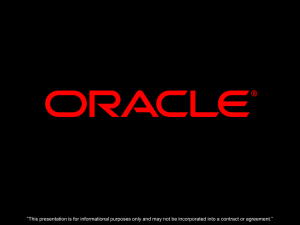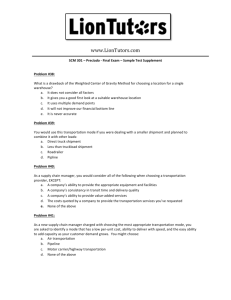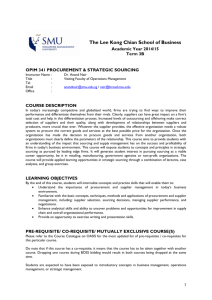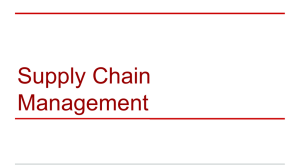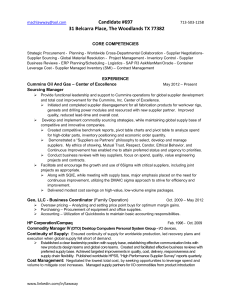Part Two: Supply Management Handbook
advertisement
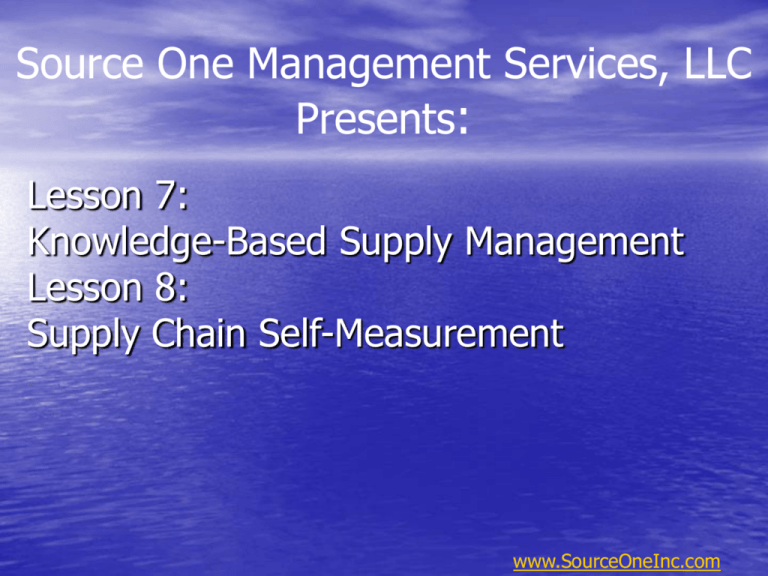
Source One Management Services, LLC Presents: Lesson 7: Knowledge-Based Supply Management Lesson 8: Supply Chain Self-Measurement www.SourceOneInc.com Lesson 7: Knowledge-Based Supply Management Knowledge-Based Supply Management A process driven by factors that influence the ability of supply to contribute to the long term success of the business Factors: Knowledge about customers Organizational strategy The economy Supply base Supply is in a unique organizational position to process input from: Internal Business Partners The Supply base The Customer Base Contemporary Sourcing Models Spend-Driven Sourcing Risk-Driven Sourcing Strategy-Driven Sourcing Contemporary Sourcing Models Spend-Driven Sourcing Contemporary Sourcing Models Spend-Driven Sourcing Starts with spend analysis What is being bought For whom In what quantities Ts & Cs Resources allocated to highest spend Leads to wider application of the structured sourcing process to nontraditional purchases Benefits Energy Travel Manage Stakeholders & Supplier Relationships Implement Strategy Source & Select Suppliers Develop Category Strategy Conduct Market Analysis Determine needs Conduct spend analysis Spend-Driven Sourcing Spend-Driven Sourcing Conduct Spend Analysis * Determine Needs* Conduct Market Analysis* Develop Category Strategy* Manage Stakeholders & Supplier Relationships Implement Strategy Source & Select Suppliers Develop Category Strategy Conduct Market Analysis Determine needs Conduct spend analysis Source & Select Suppliers* Implement Strategy* Manage Stakeholders & Supplier Relationships Spend-Driven Sourcing Better understanding of spend by category Policies tailored to each category Categories prioritized Categories more easily defined Target Supply Management Knowledge Base to Appropriate Spend Category Spend-Driven Sourcing BASICALLY… Getting the right person to find the right thing for the right place at the right time for the right price from the right supplier with the right level of service! Risk-Driven Sourcing Sourcing begins identifying the risks to the company supply Assess risk and institute risk mitigation strategies Know the company mission Understand the impact of supply strategies and programs This puts the focus on the root causes of risk New suppliers Riskier supply chains (overseas) High levels of customization Risk-Driven Sourcing Bottleneck Strategic Noncritical Leverage Risk-Driven Sourcing Medium-High Risk Bottleneck •Unique specifications •Supplier’s technology important •Substitution is difficult •Unpredictable usage •Few sources of supply Strategic Noncritical Leverage Risk-Driven Sourcing Medium-High Risk Bottleneck Noncritical Strategic •Availability essential •Supplier technology important •Few suppliers •Supplier switch difficult •Substitution difficult Leverage Risk-Driven Sourcing Bottleneck Strategic Low-Medium Risk Noncritical •Standard spec or commodity item •Easily substituted •Many sources Leverage Risk-Driven Sourcing Bottleneck Strategic Low-Medium Risk Noncritical Leverage •Standard spec or commodity item •Volume price breaks (price is key) •Substitution possible •Several sources It is important to know what approach best fits your company! Risk-Driven vs. Spend-Driven Brand X Brand Y Spend 1. 2. 3. 4. 5. Aluminum Copper wire Plastic molding Microchips Speakers $14.7m $8.3m $7.6m $7.3m $5.7m 11. Light sensors $1.3m Strategy-Driven Sourcing Start with A company-wide Strategic Plan incorporating input from all the relevant stakeholders Resources are allocated to purchases that have the greatest potential impact Maximize opportunities Minimize risk Is a purchase strategic or operational? Operational has little effect on final customers Strategic impacts final customers or has significant impact on company’s bottom line. Apply a strategy to fit the purchase Evaluating & Selecting Suppliers Too few suppliers often leads to sub-par results Properly specifying the requirement is essential Two step process Identify suppliers that could be considered Narrow the list to perform a better analysis First-Cut Strategic Considerations Develop criteria for finding sources Classify purchases according to strategy Immediate considerations: Incumbent performance Single source vs. multiple suppliers Vendor size/capabilities Location Supplier relationship desired Contract length Type of supplier External considerations Financial viability Narrowing the Field Evaluate a Supplier’s Ability to Perform Quality assurance Operational capability Logistics and distribution Service Finances Organization/Management Labor issues Legal issues Narrowing the Field Analyzing Supplier Performance A formalized performance measurement program increases discipline and consistency Narrowing the Field Analyzing Supplier Performance Characteristics of a Successful program: Key Performance Indicators Designed Metrics to distinguish suppliers Aligned with organizational strategy Clearly defined and prioritized Encourage desired behaviors Price Cost and Metrics Different ways to measure Overemphasis may miss bigger financial picture Full cost analysis leads to more robust understanding Narrowing the Field Analyzing Supplier Performance Characteristics of a Successful program: Quality Does it meet specifications? Value of exceeding specs? Cost of underperformance? Price Cost and Metrics Delivery Freight Costs Improper delivery inventory Service Different ways to measure Problem Overemphasis may miss bigger financialResolution picture Support availability Full cost analysis leads to more robust Clearly defined prior to Quote understanding Objective scoring Narrowing the Field Analyzing Supplier Performance Supplier Performance Rating Methods: Categorical Method keep a records of all suppliers and their products and services Establish a list of factors to grade Periodic evaluation Cost-Ratio Method Identifies all costs to the value of each shipment The lower the ratio, the higher the rating Weighted-Point Method Each factor assigned a weighted value Each factor graded Our approach for AmeriGas Market Intelligence “Sustainable intelligence is required to successfully and continually turn information and data into usable and actionable knowledge” Three key areas: 1. Identification of supply opportunities 2. Prediction of future trends 3. Identification of lower cost alternatives to meet requirements Chapter 8: Supply Chain Self-Measurement Supply Chain Self-Measurement The fall of communism Market driven economies in Southeast Asia End of African Colonialism innovation Technology Robust Global Economy The world was both stable and experiencing unprecedented growth Terrorism War Rising Gas Prices Global Uncertainty The World is now at Risk Supply Chain Self-Measurement Globalization requires supply professionals to manage risk better Supply The Management World is now is NOT at Risk exempt Globalization requires supply professionals to manage risk better Globalization requires supply professionals to manage risk better “Supply Professionals no longer have the luxury of not knowing what best practices are and how their operations (and Supply chains) compare to those practices.” Formalize expectations Understand potential risk Have measurement protocols in place Pre-qualify sources of supply Avoid Disruptions to supply! Globalization requires supply professionals to manage risk better Know Your Role! Know Your Place! Know Your Plan! “Supply Professionals no longer have the luxury of not knowing what best practices are and how their operations (and Supply chains) compare to those practices.” Know Your Role! Know Your Place! Know Your Plan! Differentiate between the levels of value and risk to identify operational importance and to manage risk Operational Critical Transactional Commodity Scope of measurement and evaluation process Collaborative Process Interdisciplinary (external & Internal) Involve all stakeholders Supply must orchestrate requirements and expectations No longer is supply just going through a buyer or purchasing department There are now multiple points of contact across multiple levels of the company It is, therefore, now necessary to assess both supplier performance and also measure how well supply manages the supply chain Scope of measurement Supply Profiles and evaluation process Supply management should set standards for qualitative and quantitative criteria to evaluate form fit functionality The supply professional must understand: Concept of supply management How measurements are applied Elements and implications of measurement How this will improve profits, efficiency, and progress When incentive-based performance measurements are appropriate Impact of supply management on development and long-term relationships Supply Profiles The emphasis of Supply measurement is the development of supplier assessment and evaluation profiles that quantitatively and qualitatively measure capabilities and performance Key questions when developing a profile: 1. Organizational structure –where do functions and process reside 2. Information systems and operating protocols 3. Locations, physical assets, location capabilities 4. Supply chains to supply chains…looking further down the line 5. Financial stability of the supplier/protections in place 6. Management team Supply Profiles This profile will show how the supply chain manages… Order Management Personnel Development Customer Service Quality Cash Flow Supply Commitment Compliance Commitment Social Responsibility Research & Development Cost Competitiveness Logistics Finances Inventory Project Management Supplier data baseline profile Research what the experts and industry leaders think Then do your own worse better good Evolving and ongoing process Self-assessment of capabilities and attributes Comparative analysis in order to rank Create benchmarks Competitive analysis for future RFP Identify new opportunities Key supplier performance matrices Deliver materials or services on time Two requested basic tenants Delivery performance measurements Quantitative performance Cost-effective materials and services Qualitative performance Inventory accuracy Supply’s responsibility to formalize measurement process Weekly surveys Actual performance Current concerns to specific situation Open-ended questionaire Supply chain performance against changing stakeholder requirements Cycle time reductions in processes and resources Reduction in process cycle times exposes process problems Improves resource management Reduces overall costs Is a Critical success factor Lowering inventories Improving customer service Improving quality More efficient Knowledge-Based Supply Management A process of using the skills and information available to the supply team to best tailor a supply initiative to the specific supply opportunity. Supply chain self measurement Allows the supply management team to ensure that the supply initiatives it has instituted are successful by creating a means to objectively measure performance So what’s it all mean? Resources: The Supply Chain Management Handbook – 7th Edition Part Two: Going To Market With Today’s Crucial Imperatives

